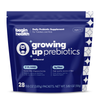Supporting Fiber Intake in Kids with Autism
share this article

Kids with autism spectrum disorder (ASD) may have unique dietary preferences and sensory sensitivities that can pose challenges when it comes to meeting their nutritional needs, including fiber intake. Let’s review some practical strategies for parents to increase fiber intake in kiddos with autism:
Offer a Variety of Fiber-Rich Foods
Introduce a wide range of fiber-rich foods in different textures and forms to accommodate sensory preferences and promote acceptance. Incorporate fruits, vegetables of all shapes, colors, and sizes into meals and snacks and allow your kiddo to choose their favorite as a way to provide diverse sources of dietary fiber.
Daily reads to help your little ones lead happier and healthier lives.
Join the
Happy Gut Club
Use Visual Supports and Reinforcement
Utilize visual schedules, charts, and social stories to introduce new foods and encourage fiber-rich choices. Using visuals along with positive reinforcement, such as praise or rewards, can help motivate kids with autism to try new foods and expand their dietary repertoire.
Incorporate Fiber into Preferred Foods
Enhance the fiber content of familiar foods by incorporating hidden sources of fiber, such as adding pureed vegetables to sauces, smoothies, or baked goods. This allows your kiddo to enjoy their favorite foods in addition to new ones.
Begin Health Expert Tip
While we always recommend starting with whole fruits and vegetables as a way to increase fiber intake in kids, we know it’s not always easy to get them to eat enough of these foods. Incorporating a prebiotic fiber supplement such as Begin Health’s Daily Growing Up Prebiotics can help boost your kiddo’s fiber intake without adding taste or texture. Just add a serving to their daily water or favorite beverage for 3g of daily fiber support from chicory root.
Gradually Increase Fiber Intake
Introduce fiber-rich foods gradually and monitor your kiddo’s tolerance and acceptance. Slowly increasing fiber intake over time can help prevent digestive discomfort and promote long-term dietary adherence.
Summary
Increasing fiber intake in kids with autism can be challenging due to sensory sensitivities and dietary preferences, but with patience, creativity, and support, parents can help their child achieve a balanced and nutritious diet. By offering a variety of fiber-rich foods, utilizing visual supports, incorporating fiber into preferred foods, gradually increasing fiber intake, and seeking guidance from healthcare professionals, parents can support their child's overall health and well-being.


















